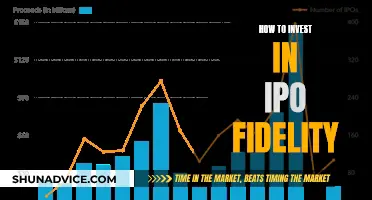
Index funds are a great way to build wealth over time, especially for retirement. They are a group of stocks that mirror the performance of an existing stock market index, such as the S&P 500. An index fund will have the same investments as the index it tracks, so its performance closely mirrors that of the index, without the need for hands-on management.
Index funds are a passive investment strategy, so they don't require active management or frequent trading, which keeps costs low. They are also well-diversified, reducing the risk of loss.
You can invest in index funds through a brokerage account, a traditional IRA, or a Roth IRA. When choosing an index fund, it's important to consider the fund's investment objective, management style, and costs. While index funds tend to have lower fees than actively managed mutual funds, it's still important to compare costs, as even small differences in fees can have a significant impact on your retirement savings over time.
| Characteristics | Values |
|---|---|
| Investment Options | Actively managed mutual funds, index funds, individual stocks, real estate |
| Investment Objective | Capital appreciation, stable income |
| Management Style | Actively managed, passively managed |
| Investment Holdings | Actively picked by fund managers, automated to track underlying index |
| Costs | Actively managed funds: 0.65% expense ratio, actively managed funds with higher trading costs. Index funds: 0.05% expense ratio |
| Tax Implications | Tax-free growth and withdrawals in a Roth IRA |
| Income Generation | Dividends, capital gains |
What You'll Learn

Understand the difference between index funds and actively managed mutual funds
Index funds and actively managed mutual funds are two types of investment funds that differ in several key ways. Here are the details to help you understand the differences between the two:
Management Style:
- Index Funds: Index funds are passively managed, meaning they aim to mirror the performance of a specific market index, such as the S&P 500 or the Dow Jones Industrial Average. The fund's holdings automatically track the chosen index, and there is no need for active buying and selling decisions. This makes index funds a passive investing strategy.
- Actively Managed Mutual Funds: In contrast, actively managed mutual funds employ professional fund managers who actively select and trade investments to try to outperform the market. These managers rely on their research, expertise, and market forecasts to make investment decisions.
Investment Objective:
- Index Funds: The primary goal of index funds is to replicate the performance of the chosen market index. They seek market-average returns and do not aim to beat the market.
- Actively Managed Mutual Funds: The objective of actively managed mutual funds is to outperform the market and generate higher returns than the overall market. Fund managers try to beat a specific benchmark or market index by strategically selecting investments.
Cost:
- Index Funds: Index funds typically have lower costs and fees compared to actively managed funds. This is because they involve less frequent trading, lower administrative expenses, and no investment manager salaries. Index funds are known for their low investment costs.
- Actively Managed Mutual Funds: Actively managed funds incur higher fees due to active trading, research, and management costs. These fees include expense ratios, sales loads, and transaction fees. The higher fees can sometimes lead to underperformance relative to index funds.
Diversification:
- Index Funds: Index funds offer instant diversification by holding a high number of securities in the same proportions as the tracked index. This provides broad market exposure and reduces specific risks associated with individual stocks or sectors.
- Actively Managed Mutual Funds: The diversification of actively managed mutual funds varies as the fund manager selects specific securities to meet their investment objectives. Some funds may hold a diversified portfolio, while others may focus on specific sectors or niches, resulting in varying levels of diversification.
Risk:
- Index Funds: Index funds tend to have higher market risk but lower strategy risk than active funds. They carry the market risk inherent in the underlying index, exposing investors to fluctuations in the overall market. However, this risk is spread across a diversified portfolio.
- Actively Managed Mutual Funds: Actively managed funds may bear market risk and specific risks tied to the fund's investment strategy or manager's decisions. They may have higher expense ratios, potentially leading to underperformance against the market.
Tax Efficiency:
- Index Funds: Index funds are generally more tax-efficient than active funds. They tend to have lower turnover rates, resulting in fewer taxable capital gains distributions. Their buy-and-hold approach minimizes taxable events.
- Actively Managed Mutual Funds: Actively managed funds may experience higher turnover, triggering more capital gains distributions taxable to investors. However, some mutual fund managers use tax management strategies, such as offsetting gains against losses and holding stocks for the long term, to minimize tax implications.
Managed Funds: Choosing and Investing in a Smart Way
You may want to see also

Know the investment options for a Roth IRA
When constructing a portfolio for your Roth IRA, you have a variety of investment options to choose from. A few core index funds, including exchange-traded funds (ETFs) and conventional mutual funds, should be enough to meet most investors' diversification needs at a minimal cost.
U.S. Stock Index Funds
One of the central building blocks of a long-term retirement portfolio is a broad-based, passively-managed (and thus low-cost) U.S. stock index fund, which will serve as the main driver of growth for most investors. You can choose either a total market fund or an S&P 500 index fund. U.S. total market funds attempt to replicate the performance of the entire U.S. equity market, including small-cap and mid-cap stocks, whereas an S&P 500 index fund is focused entirely on large caps. Small- and mid-caps may exhibit higher volatility but produce higher returns.
U.S. Bond Index Funds
Adding a U.S. bond index fund to your investment portfolio will help reduce your portfolio's overall risk over time. Bonds and other debt securities typically offer investors more stable and secure sources of income compared to stocks, but they tend to generate lower returns. A low-cost bond fund that tracks a U.S. aggregate bond index can provide investors with broad exposure to this less risky asset class most of the time.
Global Stock Index Funds
You can diversify your portfolios further by adding a global stock index fund that holds a broad selection of non-U.S. stocks. A long-term portfolio that includes a global stock index fund provides exposure to the broader world economy and lessens exposure to the U.S. economy in particular. Inexpensive funds that track an index like the MSCI ACWI (Morgan Stanley Capital International All Country World Index) Ex-U.S. or the EAFE (Europe, Australasia, Far East) Index provide broad geographical diversification at a relatively low cost.
Dividend Stock Funds
Dividend stock funds are another popular option. Companies that pay dividends tend to be in mature industries and generate a ton of cash, allowing them to distribute the money to shareholders. The best companies increase their payouts annually for decades, turning your investment into a dividend dynamo. Plus, they tend to be less volatile than an average fund. Dividend stock funds can be particularly attractive in a Roth IRA because of their relative safety and the fact that the dividends are not subject to tax.
Value Stock Funds
Value stock funds include stocks that are more value-priced than the rest of the market, helping you find the stocks that are relative bargains. That means value stocks tend to be less volatile than the rest of the market, and they tend to have good returns over time. Plus, many of these companies also pay dividends, meaning you can enjoy attractive returns plus a cash payout. Because of their (usually) lower volatility, value stock funds may make an attractive addition to a Roth IRA.
Nasdaq-100 Index Funds
A Nasdaq-100 index fund focuses on the largest names trading on the Nasdaq exchange, which is chock full of tech firms you might use every day, including Amazon, Apple and Meta Platforms (formerly known as Facebook). This kind of fund gives you high exposure to these top players, even more than you'd get in an S&P 500 index fund, supercharging your returns if these stocks do well. If you believe in the continued growth of tech stocks, this kind of Nasdaq fund is a great place to invest, potentially for decades. You'll get some diversification and may be able to compound your money at attractive rates. Of course, inside a Roth IRA, you won't pay any capital gains taxes, either on your sales or when you make a qualified withdrawal from the account.
Mutual Funds vs Real Estate: Where Should You Invest?
You may want to see also

Learn how to choose the right index fund for your Roth IRA
When choosing the right index fund for your Roth IRA, it's important to keep in mind that you want to focus on investments that have a strong likelihood of growing over the long term, but with little chance of loss. Here are some tips to help you choose the right index fund:
- Have a clear goal in mind: Before investing in index funds, it's crucial to understand your financial objectives and risk tolerance. Determine whether you're looking for short-term gains or long-term growth, especially if you're saving for retirement.
- Research different index funds: Familiarize yourself with the various types of index funds available, including those that focus on company size, geography, business sector, asset type, and market opportunities. Consider your desired level of diversification and the specific sectors or industries you want to target.
- Evaluate fees and costs: Index funds are known for their low costs, but it's important to compare management fees, expense ratios, and other potential costs across different funds. These fees can eat into your investment returns over time.
- Consider your risk tolerance: Assess your risk tolerance and how much volatility you're comfortable with. If you're averse to risk, opt for more established companies and sectors. If you're willing to take on more risk, consider funds with a higher potential for growth, such as small-cap or emerging market funds.
- Diversify your portfolio: Diversification is key to managing risk and maximizing returns. Consider investing in a mix of index funds that target different sectors, industries, or asset classes. This will help spread out your risk and potentially increase your overall returns.
- Seek expert advice: Consult a financial advisor or a tax professional to ensure that your investment choices align with your financial goals and risk tolerance. They can provide personalized advice based on your unique circumstances.
- Vanguard Wellesley Income Fund Investor Shares (VWINX): This fund offers a blend of income generation and capital preservation, with a focus on stocks and bonds. It has a high yield and a relatively low expense ratio.
- Vanguard Total Stock Market Index Fund Admiral Shares (VTSAX): This fund tracks the CRSP U.S. Total Market Index, providing exposure to a diverse range of domestic stocks. It has a low turnover rate and has been tax-efficient historically.
- Fidelity Blue Chip Growth Fund (FBGRX): This actively managed fund focuses on blue-chip stocks, exhibiting growth traits while providing higher returns than the Russell 1000 Growth Index.
- Schwab U.S. REIT ETF (SCHH): This ETF offers low-cost exposure to real estate investment trusts (REITs), which are known for their favorable dividend payouts. It provides diversification across various REIT sub-sectors.
- Avantis Moderate Allocation ETF (AVMA): This fund of funds provides exposure to global equities and fixed income, focusing on smaller, potentially undervalued companies. It offers a balanced target allocation and has a relatively low expense ratio.
- IShares Bitcoin Trust ETF (IBIT): This ETF provides exposure to the high-growth asset class of Bitcoin, allowing you to diversify into cryptocurrencies within your Roth IRA. However, it comes with higher volatility and risk.
- SPDR Bloomberg High Yield Bond ETF (JNK): This fund focuses on high-yield corporate bonds, providing higher income generation but also carrying a higher credit risk. By holding this ETF in a Roth IRA, you can enjoy the full distribution potential.
Gold Fund Investment: A Beginner's Guide to Getting Started
You may want to see also

Find out how to buy index fund shares
Index funds are a low-cost, easy way to build wealth. They are a group of stocks that mirror the performance of an existing stock market index, such as the S&P 500. Index funds are passively managed, meaning they don't need to actively decide which investments to buy or sell. This passive management strategy makes them a good option for balancing the risk in an investor's portfolio.
- Have a goal for your index funds: Know what you want your money to do for you. If you're looking for a short-term investment, index funds may not be the best option. But if you're looking to let your money grow slowly over time, particularly for retirement, index funds can be a great choice.
- Research index funds: Consider the following factors when researching index funds: company size and capitalization (small-, mid-, or large-cap indexes), geography, business sector or industry, asset type, and market opportunities. You may only need to invest in one broad stock market index, but you can also customize your fund mix if you want more exposure to specific markets.
- Pick your index funds: Cost is often a deciding factor when choosing an index fund. Look for funds with low management costs, as these fees can impact your long-term investment returns.
- Decide where to buy your index funds: You can purchase index funds directly from a mutual fund company or a brokerage. When choosing where to buy, consider fund selection, convenience, trading costs, impact investing, and commission-free options.
- Open an investment account: To purchase shares of an index fund, you'll need an investment account. You can use a brokerage account, individual retirement account (IRA), or Roth IRA.
- Buy the fund: When purchasing the fund, you may be able to select a fixed dollar amount or choose a number of shares based on the share price and your budget.
- Keep an eye on your index funds: Monitor the performance of your index fund to ensure it is mirroring the underlying index. Also, be mindful of any fees that may start stacking up over time, as these can impact your returns.
Remember, investing in index funds, like any investment, carries the risk of losing money. Be sure to do your research and understand the risks and potential returns before investing.
Mutual Funds: Why They're a Popular Investment Choice
You may want to see also

Weigh the pros and cons of investing in index funds
Index funds are a great investment for building wealth over the long term. They are a group of stocks that mirror the performance of an existing stock market index, such as the Standard & Poor's 500 index.
Pros:
- Low costs: Index funds are cheap to run because they are automated to follow shifts in value in an index.
- Diversification: Index funds invest across many different securities, which is less risky than investing in just a couple of securities.
- Passive management: Index funds are passively managed, meaning they don't need to actively decide which investments to buy or sell. This can save investors time and effort.
- Performance: Index funds tend to outperform actively managed funds over the long term due to lower costs and less volatile market swings.
Cons:
- Fees: While index funds have lower fees than actively managed funds, they still carry administrative costs that can affect long-term investment returns.
- Limited control: With index funds, investors have less control over the specific investments in their portfolio.
- Potential underperformance: In some cases, index funds may underperform the market or fail to beat the market over the long term.
Closed-End Funds: Registered Investment Companies Explained
You may want to see also
Frequently asked questions
Index funds are a group of stocks that mirror the performance of an existing stock market index, such as the S&P 500. Index funds are passively managed, meaning they don't require active decision-making, and are therefore a low-cost investment option.
You can open a brokerage account, a traditional IRA, or a Roth IRA to invest in index funds. You can also invest through your employer's 401(k) plan. When choosing a provider, consider factors such as fund selection, convenience, trading costs, and commission-free options.
Index funds offer a low-cost, diversified investment option for those saving for retirement. They provide tax advantages, such as tax-free growth and withdrawals, and allow you to maximize returns while minimizing risk over the long term.







